Journal of Xenoanthropology,
June 2341
edited by Leslie Fish
INTRODUCTION
Much that appears bizarre and bewildering about Andorian culture - its violence, territoriality, demanding etiquette, clan-based social structure, contradictory sexual morality, oddly primitive religion and art, grim practicality and tendency toward fratricide - becomes comprehensible when one learns the nature of Andorian biology. Andorian culture appears to be shaped almost entirely by biology, and attempts to reach beyond biology meet with only partial success.
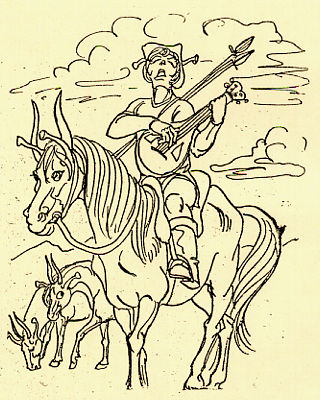
GENERAL DESCRIPTION
Andorians are a comparatively tall species, averaging between 1.7 and 2.1 metres in height. Although obesity is not unknown, it is culturally condemned and most Andorians are quite slender for their height. This often gives them a misleading appearance of fragility, which is belied by their remarkable physical strength. Due to the extreme density of bone and muscle tissue, the average Andorian is quite capable of lifting an object of twice his or her weight. Thus in the famous ballad 'Baron Hathiye' it is not to be taken purely as fable that the hero...
"... stood upon his ramparts, defying one and all,
And then picked up his treacherous steed and threw it over the wall.
Sing: waily, waily, and the silver leaves are tossing."
COLORATION AND ITS EFFECTS
The spectacular coloration of Andorians is the result of a proteinous dye, HZB-41, analogous to melanin in humans, which is produced by nearly all Andorian animal life. The dye-cells have a comparatively short life span and must be produced constantly from protein sources in the diet. One of the most common symptoms of serious illness is insufficient dye production and a corresponding loss of skin colour. In the folklore, ghosts and walking-dead and other supernatural visitants are always described as "ghastly pale". This perhaps explains one of the early difficulties in contact between the Andorian Empire and humans. Possibly the unfortunate reaction to the appearance of the first contact team can be explained by an excerpt from the ancient ballad, 'The Ghost Brother':
"His face in the light was as pale as his hair,
And Rashilla fell weeping in dread and despair.
'Put back the helmet and leave,' she said,
'For now I know that thou surely are dead!'
Sing: waily, waily, and the long grasses grow."
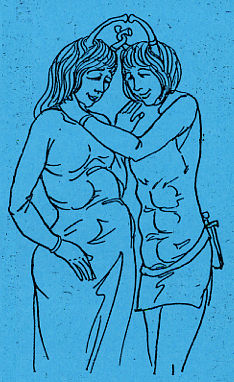
SIGNIFICANCE OF THE ANTENNAE
The most remarkable of the Andorian physical features are the antennae, which are set slightly higher on the head than ears on a human. These are highly sensitive, semi-rigid structures of muscle and cartilage, their tips containing directional hearing organs, the long-distance heat-sensing organs and the telepathic sensors which play an important part in the reproductive cycle. The antennae also express emotion, far more than do the facial muscles, and are the prime indicators of Andorian body language. They express polite interest by curving toward the object of attention, fear or excitement by standing rigid and quivering, weariness or depression by drooping, confusion or upset by wringing and lashing, sexual arousal by slow writhing, intoxication by wobbling unsteadily in different directions, and rage by pressing back against the skull. Andorians "kiss" by touching the tips of their antennae together.
Because of the importance of the antennae, much of Andorian psychology revolves around these organs. Fear of damage to the antennae is deeper and more widespread than castration-anxiety in humans. Loss of antennae to an Andorian is the equivalent of deafness, muteness, castration and mutilation of the face to a human, and no Andorian will voluntarily survive such an injury.
Subsequently, the uninvited touching of the antennae is considered an unpardonable rudeness, and the threat of injury to antennae is legitimate grounds for assault and murder - as occasional, unfortunate incidents have shown. For example, in the famous tapestry 'The Assault on Yodina', one notes that Yodina is actually leaning toward the captor who has imprisoned her arms and away from the villainous baron who has clutched her left antenna. To the student of Andorian culture, it comes as no surprise that Yodina's relatives later tore the wicked baron into several pieces and fed the fragments to their hunting beasts before a cheering crowd.
Because of the telepathic organs and their relation to the reproductive process, the antennae are also considered proper sites for valuable jewelry, particularly gifts from friends, lovers and mates. The Andorian version of the wedding ring is worn on the left antenna rather than on a finger. To give an Andorian antenna-rings or antenna-bells is to make a gesture of great friendship, if not of courtship.
CULTURAL EFFECTS OF DIET
The Andorian nervous system requires great amounts of complex protein for its maintenance and growth, protein which is not available from the few edible nuts, fruits and grains found on Andor. Also, though most Andorian food beasts are mammals, their milk production is limited and reserved for their litters of young, so there is no Andorian dairy industry. Consequently, the Andorian diet is largely carnivorous. Andorians raise a large variety of livestock, and hunt many non-domesticable species. It is not true, as early contact teams suggested, that Andorians will eat anything that walks, flies or crawls through the grass; they do not, for instance, practice cannibalism - except in cases of extreme emergency.
Certain nuts and fruits are considered condiments, desserts or emergency rations but, for the most part, Andorians look on vegetables as livestock feed. The most important of these is fat-grass, a grain-bearing plant that grows wild in great abundance all over Andor. In nutritive qualities, fat-grass is analogous to high fat-content quadrotriticale; in its ubiquity, vitality, and persistence, it is analogous to crabgrass. It spreads by seed and creeper and can survive in any soil - although it grows best when fertilised by livestock droppings and the bodies of the dead. Andorians have long been aware of this, and subsequently practice burial instead of cremation. Indeed, the Andorian word for "burial" is feeding the fat-grass - and The Mother of Fat-grass, a major Andorian deity, is also called The Comforter of the Dead.
Because Andorians require such large amounts of meat, livestock-raising has long been of primary importance to Andor's economy. This dependence on herds of livestock is the cause of several cultural conventions. For example, the Andorian word for "war" derives from the ancient term for livestock-raid, the word for "wedding gift" from basic breeding herd, "trade" from exchange of livestock, "disaster" from loss-of-livestock and "home" from grazing range.
Andorian currency is based on the value of livestock. The largest denomination is the teeghar, from teegh (the largest domestic animal, roughly equivalent to the Terran horse or cow). Smaller denominations include the sleemhar (roughly value of a domesticated reindeer), the nohagar (value of a large pig), the ashklar (value of an antelope), and the mefilhar (value of a small goat).
The smallest coin, the pramhar (value of a guinea pig), has especially interesting connotations. Because of long-standing cultural pressure, no family would dare to be without at least a token number of food-beasts; for urban dwellers, this means maintaining a number of pramha (which can be kept in a small cage) and a window-box garden of fat-grass to feed them. Thus, the term pramha farmer can refer to a very poor family or an urban family. By a pun, it can also mean a penny-pinching miser or a person of small resources and large pretensions. In the ballad 'The Tragedy of Jalrhain', the heroine is described as servant to a pramha farmer to indicate her poverty, misery and desperation; this is her motivation for her subsequent violence to her employer and his entire clan.
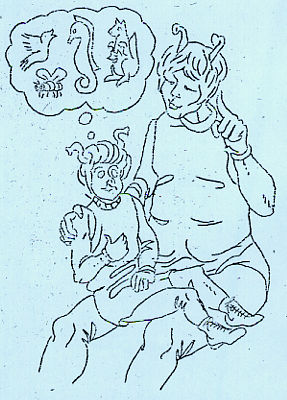
COMPLEXITY OF THE REPRODUCTIVE MECHANISM
The single most important feature of Andorian physiology is the complex reproductive mechanism. It can be said that Andorians explain the facts of life to their children in terms of the birds, the bees, the seahorses and the kangaroos. Yet for all its complexity, it is a tremendously efficient system - so efficient, in fact, that over-population has been a primary social problem throughout all recorded Andorian history.
It is difficult, if not impossible, to determine the sex of an Andorian child at birth, with the result that children are raised without different treatment accorded by gender. This is one reason why Andorian society is completely ambiarchal. The child's genital organs remain dormant until first puberty, which starts at the approximate age of 12 and is completed by the age of l5, when s/he begins the neuter phase of adulthood. At this time, the sex of the individual first becomes apparent. The male possesses a retractable penis, subcutaneous testes, a uterus and a semi-extensible vagina; the female possesses a uterus and vagina which ends in a retractable ovipositor, a ventral pouch, and six breasts - flat and dormant in the neuter phase and arranged in pairs from chest to abdomen.
Since the sexual activity of neuters does not result in pregnancy, it is given little social importance and is described by the word "play" or "amusement". Neuters are allowed, if not encouraged, to experiment sexually in any way that interests them and are restricted by no taboos whatever. A neuter may "play" with its brothers, sisters, other relatives, friends, enemies, strangers and livestock; nobody cares, unless the activity results in physical injury, which is then treated as a simple case of assault. Although passionate, emotional involvement can form between playing neuters - and are celebrated in story and song - they are not considered in the same category with attachment to one's true mate. The resulting sexual liberality of neuters often puzzles outsiders and has led to some unfortunate misunderstandings, as related in Khardillye's modern poem, 'The Flat-Antennaed ("eared") Stranger':
"Incomprehensible playmate, last night's friend,
Why art thou displeased by daylight, tell?
Have we not played happily all night long?
Enjoying every protrusion and orifice well?
Why, then, this post-sleep change?
Why this attempt to press guinea-pig coins in my hand?
Why your suggestion I hide when the landlady knocked?
Why this insistence on leaving by separate doors?
I believe I detect in your manner a note of contempt.
Ignoring my backswept antennae, you press me too far.
Indeed, we shall exit by separate doorways! - Be off!
Or I'll rip out your windpipe and throw you straight out of this window!"
Second puberty occurs when a neuter forms a serious emotional attachment to a neuter of the opposite sex and their normal empathic connection deepens into a full telepathic bond. This process, known as formal courtship, lasts several months, often a year and more. During this courtship, the telepathic bonding, by a method the Andorians are reluctant to reveal, causes physiological changes that bring on full fertility: development of the female's breasts and pouch, increased size and protrusion of the male's testes and the production of gametes. From the time of the first symptoms of change, the couple is considered betrothed, and they may marry at any time before the final bonding. Final bonding consists of male's-penis to female's-vagina mating between a male with distended testes and a female with distended breasts, while both are in full telepathic rapport for the first time, and results in first pregnancy.
In a "true" mating, the fertilized zygote divides into two to eight sub-zygotes, which then grow in the female's womb for 3.7 standard months. Here they develop into eggs, which are approximately the size and shape of large baseballs, having elastic, gold shells. At the end of this stage, the parents perform a second form of mating in which the female deposits her eggs, through her ovipositor, in the uterus of the male. The eggs remain here for an additional 3.6 months, absorbing fluid through the shells and increasing embryo growth under the slightly higher body temperature of the male. At the end of this time, the shells are broken by the fetuses and reabsorbed by the male's body, and the fetuses are then deposited in the female's pouch, where they remain for an additional 3.2 months, gaining their final growth. They obtain nourishment during this period by means of two hollow, bony protrusions (called pouch-fangs) located in their double navels, with which they pierce a large blood vessel running vertically through the posterior wall of the pouch, thus plugging their circulatory systems into the mother's.
It is not uncommon for females in pouch-pregnancy to have voracious appetites, especially if they are also carrying another litter in the primary womb - and doubly so if they are also nursing still another litter at the same time. For this reason, the Andorian fertility goddess is often described as The Great Devourer, or The Inspiration of Livestock Raids. Understandably she is usually depicted as the wife of the war god.
In the interests of keeping the couple together, the mating bond causes physical changes in the nervous system so that bonded individuals cease to have sexual interest in any save their mates, and literally cannot perform a fertile mating with anyone else. "Adultery" is an unknown concept among Andorians. "Illegitimacy" is barely possible (not counting the purely social disgrace of failing to undergo the formal marriage ceremony before the final bonding) and is extremely difficult. It consists of a female obtaining an egg which is not hers and introducing it into her husband's womb during the second form of mating. This is considered a horrid disgrace and the usual punishment is death for both members of the couple - the female for having deceived her mate and the male for having been so thoroughly deceived (which implies unbearable stupidity and imperfection of the telepathic bond). Thus, when the deception is discovered in the ballad 'The Tragedy of Rokhail and Sheyarn':
"...'Wife, thou hast caused me to bear a bastard!'
Baron Sheyarn, he cried.
'I'll not endure such vile disgrace;
Better we first had died!'
Sing: waily, waily, and the gentle breezes blow.
He speared his wife through her false heart,
And pinned her against the wall.
Then he drew out his good long-sword,
And on it he did fall.
Sing: waily, waily, all down by the River Rhoe."
There is no divorce among Andorians; the marriage bond lasts for life, and the death of one partner usually causes death for the other. This is especially true if the death of one partner occurs by violence; the resulting telepathic shock causes sudden and severe stress to the heart, often resulting in fatal coronary occlusion. A widowed Andorian who survives the initial shock is still prey to psychic disorientation, endocrine imbalance and savage psychological depression; these are often sufficient to cause the widowed partner to "lay doon and dee" in a fashion familiar to any observer of telepathic and semi-telepathic races. A widowed Andorian who does survive the breaking of the bond reverts to neuter phase and never becomes fertile again. There are so many well known ballads about this subject that it would be pointless to quote from them, and it is not surprising: that sentimental human ballads about lovers dying of a "broken heart" are quite popular on Andor.
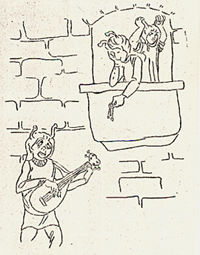
CONTINUED IN PART 2
All text and graphics © 1976, 1997, 2009 Leslie Fish. First published in Sehlat's Roar #2, a fanzine of the 70s, published by Randy Ash. Permission for me to reprint in HTML form granted by the original author/artist and the hardcopy publisher. Thank you Leslie and Randy! Star Trek © CBS Studios Inc. This weblog is not intended to infringe on copyrights held by Paramount/CBS. No text or graphics may be reproduced without permission.

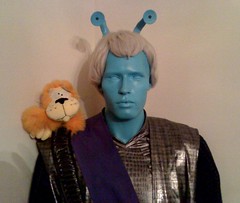



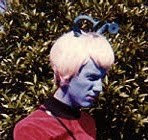

I was looking for some "information" on the subject and this blog is the best I was able to find. I like this version about the reproduction-mechanism extremelly much better than the notion of having 4 genders. I like that the male partner shares in the pregnancy.
ReplyDeleteI am exactly of the opposite opinion: the 4 gender paradigm makes the Andorians the only true aliens of Star Trek; not just humans with pointy ears or ugly brows. This reproductive mechanism here is well thought out (and the rest too) but tries to contradict the accepted soft canon (and other elements therein do to); still, it can be easily rewritten to detail the 4 genders very nicely!
ReplyDeleteActually, being written in the 70s, this article "set" a lot of fannish thinking about the Andorians. This material predated even Ballantine's "Medical Reference Manual", IIRC.
ReplyDeleteThe detail into which Andorian culture is explored can only be described as incredible! Thank you!
ReplyDelete